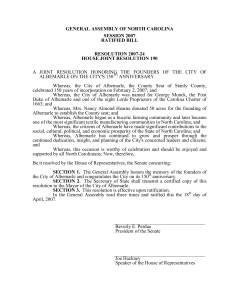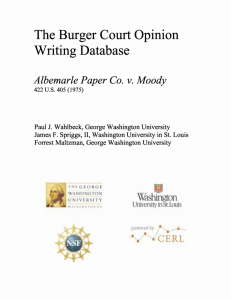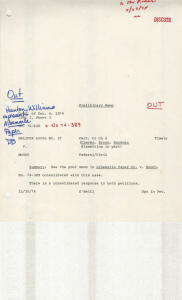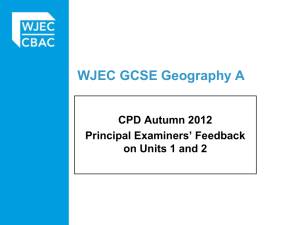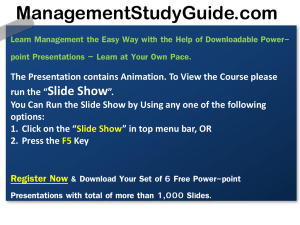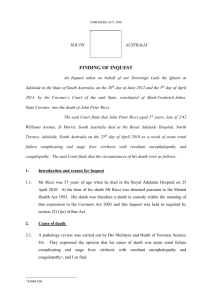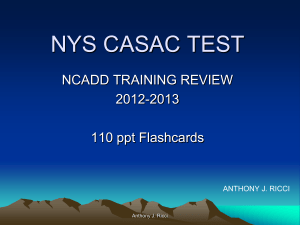Adverse Effects Cases
advertisement
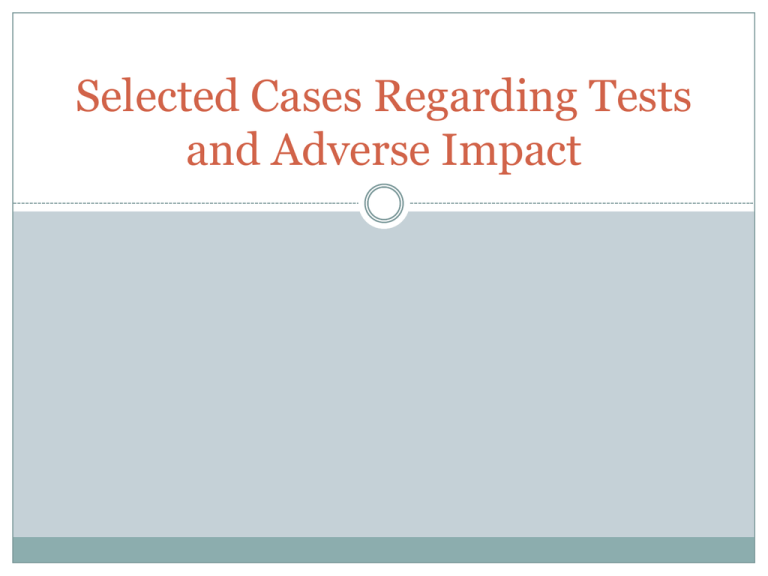
Selected Cases Regarding Tests and Adverse Impact Griggs v. Duke Power Co., 401 U.S. 424 (1971) At Duke Power Company, to qualify for placement in any section of the company other than the “Labor Department” the candidate had to have satisfactory scores on two “professionally prepared aptitude tests,” in addition to a high school education. The tests were: 1. The Wonderlic Personnel Test, which purported to measure general intelligence; and 2. The Bennett Mechanical Comprehension Test. Griggs v. Duke Power Co., 401 U.S. 424 (1971) These were “professionally prepared aptitude tests.” So, what went wrong? “Neither [test] was directed or intended to measure the ability to learn to perform a particular job or category of jobs.” Griggs v. Duke Power Co., 401 U.S. 424 (1971) Title VII allows the use of testing or measuring procedures. However, it forbids permitting these tests to control selection “unless they are demonstrably a reasonable measure of job performance.” “What Congress has commanded is that any tests used must measure the person for the job and not the person in the abstract.” In other words. . . A test can be good only if you are testing for something related to the job. Albemarle Paper Co. v. Moody, 422 U.S. 405 (1975) The company used the Wonderlic Test, but did not validate it before use “primarily, because of the expense of conducting such a validation[.]” They also used the “Beta Examination Test.” Albemarle Paper Co. v. Moody, 422 U.S. 405 (1975) Four months before trial, the employer paid a professional to validate their tests. This “expert in industrial psychology” grouped positions together based on the level of the positions in the career progression lines. Skill 1 Job Skill 2 Job “[N]o attempt was made to analyze jobs in terms of the particular skills they might require[.]” Albemarle Paper Co. v. Moody, 422 U.S. 405 (1975) The court found this method unacceptable. “A test may be used in jobs other than those for which it has been professionally validated only if there are no significant differences between the studied and unstudied jobs.” Albemarle hadn’t even tried to analyze the skills needed in the different job groups, so they failed the court’s test. Albemarle Paper Co. v. Moody, 422 U.S. 405 (1975) Additionally, a part of the validation test was to ask supervisors to rate employees so that the ratings could then be compared to the level of success on the test to determine the extent to which success on the test had a relationship to success in the eyes of the supervisor. The Problem: The criteria the supervisors were to use to assess people “was extremely vague and fatally open to divergent interpretations.” Albemarle Paper Co. v. Moody, 422 U.S. 405 (1975) BTW: The court was also unimpressed by the company’s decision to validate their test only after they were being sued. “It cannot escape notice that Albemarle's study was conducted by plant officials, without neutral, on-thescene oversight, at a time when this litigation was about to come to trial. Studies so closely controlled by an interested party in litigation must be examined with great care.” Albemarle Paper Co. v. Moody, 422 U.S. 405 (1975) Albemarle is also helpful on the issue of hiring based on not only the initial position, but also the potential of the candidate to grow into higher level positions. In order to use the test to assess future potential when selecting at an entry level, “detailed consideration must be given to the normal speed of promotion, to the efficacy of on-the-job training in the scheme of promotion, and to the possible use of testing as a promotion device, rather than as a screen for entry into low-level jobs.” Washington v. Davis, 426 U.S. 229 (1976) A test was applied to candidates seeking entry into the Police Academy. Approximately four times as many blacks failed the test compared to whites. The District Court held that the test was “directly related to a determination of whether the applicant possesses sufficient skills requisite to the demands of the curriculum a recruit must master at the police academy.” Washington v. Davis, 426 U.S. 229 (1976) According to the Court of Appeals, the disproportionate impact was “sufficient to establish a constitutional violation, absent proof by petitioners that the test was an adequate measure of job performance in addition to being an indicator of probable success in the training program[.]” Washington v. Davis, 426 U.S. 229 (1976) The Supreme Court held that that the District Court got it right, and the Court of Appeals erred. The test “was directly related to the requirements of the police training program and… a positive relationship between the test and training-course performance was sufficient to validate the former, wholly aside from its possible relationship to actual performance as a police officer.” Ricci v. DeStefano, 557 U.S. 557 (2009) 118 Firefighters took the test to qualify for promotion to Lieutenant or Captain. White candidates outperformed minority candidates to the extent that no AfricanAmerican candidates would have been selected. Some firefighters threatened to sue if the test results were used. Others threatened to sue if the results were not used. Ricci v. DeStefano, 557 U.S. 557 (2009) The company chosen to created the test (IOS) began the test-design process by performing job analyses to identify the tasks, knowledge, skills, and abilities that are essential for the lieutenant and captain positions. IOS representatives interviewed incumbent captains and lieutenants and their supervisors. Ricci v. DeStefano, 557 U.S. 557 (2009) They rode with and observed other on-duty officers. Using information from those interviews and ride-alongs, IOS wrote job-analysis questionnaires and administered them to most of the incumbent battalion chiefs, captains, and lieutenants in the Department. At every stage of the job analyses, IOS, by deliberate choice, oversampled minority firefighters to ensure that the results--which IOS would use to develop the examinations-would not unintentionally favor white candidates. Ricci v. DeStefano, 557 U.S. 557 (2009) For the oral portion of the test: IOS wrote hypothetical situations to test incidentcommand skills, firefighting tactics, interpersonal skills, leadership, and management ability, among other things. Candidates would be presented with these hypotheticals and asked to respond before a panel of three assessors. The assessors were trained for hours on how to score candidates based on pre-established criteria. Ricci v. DeStefano, 557 U.S. 557 (2009) Under the results of the test, every lieutenant vacancy would have been filled by a white person, and every captain vacancy by a person who was either Hispanic or a Non-Hispanic White. Ricci v. DeStefano, 557 U.S. 557 (2009) The Supreme Court held that an employer cannot discard a test “to achieve a more desirable racial distribution of promotioneligible candidates—absent a strong basis in evidence that the test was deficient and that discarding the results is necessary to avoid violating the disparate-impact provision.” Ricci v. DeStefano, 557 U.S. 557 (2009) “Fear of litigation alone cannot justify an employer's reliance on race to the detriment of individuals who passed the examinations and qualified for promotions. The City's discarding the test results was impermissible under Title VII[.]” Lessons learned from these cases? 1. Make sure the test is valid before it is used – not after you are sued. 2. Link the test to the duties of the position. 3. Measure for what is needed for the next step: • Testing for success in the Academy is more important than testing for success on a job you can’t have if you flunk out of the Academy. • Testing for success in the immediate position is more important than testing for skills that can be tested for at the time a promotion becomes available. 4. If the test is valid, a disparate effect does not justify ignoring it.
